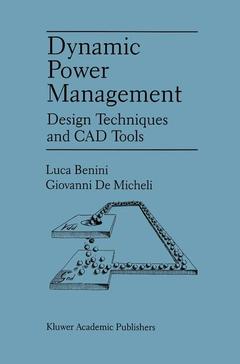Description
Dynamic Power Management, Softcover reprint of the original 1st ed. 1998
Design Techniques and CAD Tools
Authors: Benini Luca, DeMicheli Giovanni
Language: English
Subject for Dynamic Power Management:
158.24 €
In Print (Delivery period: 15 days).
Add to cart
Publication date: 10-2012
231 p. · 15.5x23.5 cm · Paperback
231 p. · 15.5x23.5 cm · Paperback
Description
/li>Contents
/li>Comment
/li>
Dynamic power management is a design methodology aiming at controlling performance and power levels of digital circuits and systems, with the goal of extending the autonomous operation time of battery-powered systems, providing graceful performance degradation when supply energy is limited, and adapting power dissipation to satisfy environmental constraints.
Dynamic Power Management: Design Techniques and CAD Tools addresses design techniques and computer-aided design solutions for power management. Different approaches are presented and organized in an order related to their applicability to control-units, macro-blocks, digital circuits and electronic systems, respectively. All approaches are based on the principle of exploiting idleness of circuits, systems, or portions thereof. They involve both the detection of idleness conditions and the freezing of power-consuming activities in the idle components.
The book also describes some approaches to system-level power management, including Microsoft's OnNow architecture and the `Advanced Configuration and Power Management' standard proposed by Intel, Microsoft and Toshiba. These approaches migrate power management to the software layer running on hardware platforms, thus providing a flexible and self-configurable solution to adapting the power/performance tradeoff to the needs of mobile (and fixed) computing and communication.
Dynamic Power Management: Design Techniques and CAD Tools is of interest to researchers and developers of computer-aided design tools for integrated circuits and systems, as well as to system designers.
Dynamic Power Management: Design Techniques and CAD Tools addresses design techniques and computer-aided design solutions for power management. Different approaches are presented and organized in an order related to their applicability to control-units, macro-blocks, digital circuits and electronic systems, respectively. All approaches are based on the principle of exploiting idleness of circuits, systems, or portions thereof. They involve both the detection of idleness conditions and the freezing of power-consuming activities in the idle components.
The book also describes some approaches to system-level power management, including Microsoft's OnNow architecture and the `Advanced Configuration and Power Management' standard proposed by Intel, Microsoft and Toshiba. These approaches migrate power management to the software layer running on hardware platforms, thus providing a flexible and self-configurable solution to adapting the power/performance tradeoff to the needs of mobile (and fixed) computing and communication.
Dynamic Power Management: Design Techniques and CAD Tools is of interest to researchers and developers of computer-aided design tools for integrated circuits and systems, as well as to system designers.
1. Introduction.- 1.1 Motivation.- 1.2 Sources of power consumption.- 1.3 Design techniques for low power.- 1.4 CAD techniques for low power.- 1.5 Power management.- 2. Background.- 2.1 Introduction.- 2.2 Boolean algebra and finite-state machines.- 2.3 Implicit representation of discrete functions.- 2.4 Markov analysis of finite-state machines.- 3. Fundamental Concepts.- 3.1 Introduction.- 3.2 Fundamentals.- 3.3 Power management circuitry.- 3.4 Conclusion.- 4. Power Management for Control Units.- 4.1 Introduction.- 4.2 Top-down synthesis.- 4.3 Top-down decomposition.- 4.4 Conclusion.- 5. Power Management for Functional Units.- 5.1 Introduction.- 5.2 Clock distribution design.- 5.3 Logic-level techniques.- 5.4 RTL techniques.- 5.5 Behavioral-level techniques.- 5.6 Conclusion.- 6. Power Management for Systems.- 6.1 Introduction.- 6.2 Operating system-based power management.- 6.3 Advanced configuration and power management.- 6.4 Modeling power management.- 6.5 The policy optimization problem 205 6.5.1 Disk power management.- 6.6 Conclusion.- 7. Conclusion.- 7.1 Summary.- 7.2 Prospects.- References.
Dynamic power management is a design methodology aiming at controlling performance and power levels of digital circuits and systems, with the goal of extending the autonomus operation time of battery-powered systems, providing graceful performance degradation when supply energy is limited, and adapting power dissipation to satisfy environmental constraints. This book addresses design techniques and computer-aided design solutions for power management. Different approaches are presented and organized in an order related to their applicability to control-units, macro-blocks, digital circuits and electronic systems, respectively.
© 2024 LAVOISIER S.A.S.




